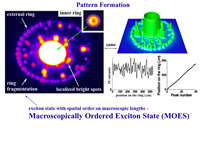Pattern formation in exciton system. Exciton rings and Macroscopically ordered exciton state |
|

|
Spatial photoluminescence PL patterns have been observed recently for excitons. The pattern features include the inner exciton rings, the external exciton rings, the localized bright spots (LBS), and the macroscopically ordered exciton state (MOES). The MOES is characterized by a periodic array of higher-density exciton beads with spatial order on a macroscopic length. The inner and external exciton rings and LBS are observed up to high temperatures and are classical phenomena. Their origin has been identified: the inner ring has been explained in terms of nonradiative exciton transport and cooling and the external rings and LBS have been explained in terms of macroscopic in-plane charge separation and exciton formation at the interface of the electron- and hole-rich regions. On the contrary, the MOES is a low-temperature phenomenon. The MOES appears in the external rings at low temperatures below a few Kelvin. Because of their long lifetime and high cooling rate, indirect excitons in coupled quantum wells (CQWs) form a system where a cold and dense exciton gas can be created. Research to understand the origin of the MOES is in progress. L.V. Butov, A.C. Gossard, and D.S. Chemla, Macroscopically ordered state in an exciton system, cond-mat/0204482 April 22, 2002; Nature 418, 751 (2002). L.V. Butov, L.S. Levitov, A.V. Mintsev, B.D. Simons, A.C. Gossard, and D.S. Chemla, Formation mechanism and low-temperature instability of exciton rings, cond-mat/0308117; Phys. Rev. Lett. 92, 117404 (2004). A.L. Ivanov, L.E. Smallwood, A.T. Hammack, Sen Yang, L.V. Butov, and A.C. Gossard, Origin of the inner ring in photoluminescence patterns of quantum well excitons, cond-mat/0509097 (2005); Europhys. Lett. 73, 920-926 (2006). |
 |

|